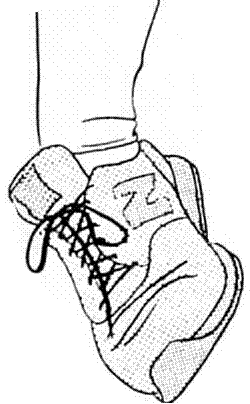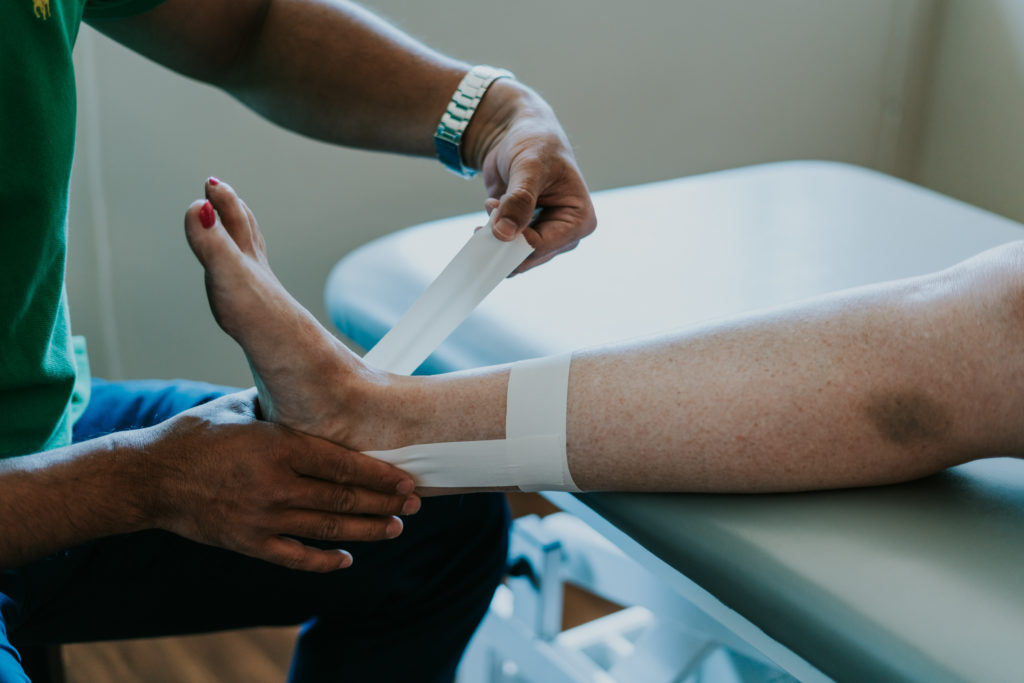Ankle Sprain
Ankle Sprains should all be treated to prevent chronic recurrence.
Ankle sprains are among the most common of all sports injuries. They can be immediately incapacitating and can quickly develop into the chronic weak ankle, the nemesis of sports participants everywhere.
However, if treated promptly and effectively almost all of these injuries heal well and allow a fast and safe return to activity.
The normal ankle bends up and down. It is supported on the outside by the 3-banded lateral ligament (most commonly injured from front to back) and on the inside by the broad medial ligament. Underneath the ankle joint is the sub-talar joint, which allows side- to- side tilting of the heel. This enables comfortable walking on uneven ground.
HOW IS IT INJURED?
The u sual injury is an inversion sprain or inward turning of the ankle (as shown), which takes the ligaments beyond their ability to naturally stretch and recover. This results in the tearing of the tissues to varying degrees. It typically occurs with jumping or cutting sports, when there are weak lower leg muscles, with poor or inappropriate footwear and when on uneven ground surfaces.
sual injury is an inversion sprain or inward turning of the ankle (as shown), which takes the ligaments beyond their ability to naturally stretch and recover. This results in the tearing of the tissues to varying degrees. It typically occurs with jumping or cutting sports, when there are weak lower leg muscles, with poor or inappropriate footwear and when on uneven ground surfaces.
There are three degrees of ankle sprain injury.
1st Degree – The ligaments are stretched but not torn. There is minimal swelling and no instability. Sport is usually resumed within a couple of weeks.
2nd Degree – This is more serious. The ligaments are partially torn. There is bleeding into the tissues and bruising usually appears within a couple of days. There is swelling and stiffness and it is usually painful. Treatment is required (the sooner the better) and it is at least 3 to 6 weeks before activity resumes. A protective brace or taping is often needed to aid recovery
3rd Degree – This is the most severe tear or possibly even complete rupture of the ligaments but surgery is seldom required. There is usually severe swelling and pain. Therapy is very important for the best recovery. Full healing may take several months. There is usually permanent laxity or looseness of the ligament/s and a brace should be used to assist with stability, healing and resumption of full activity.
ANKLE SPRAIN TREATMENT: EARLY IS BEST!
In the first 72 hours -Remember R.I.C.E. to reduce pain and swelling and prevent further damage. Rest – Don’t walk and if necessary use crutches. Ice – Ice the ankle (frozen peas make a good ice pack) for 15 minutes each 2 hours during the day. Compression — Use a tensor wrap. Your therapist will show you how to correctly apply it for maximum effect. Elevation – keep the ankle up (above the level of your heart) as much as possible.
In addition to immediate first aid, start physiotherapy as soon as you are able. At Burrard Physiotherapy, we will be able to provide assessment of the injury severity and provide you with immediate, early guidance on the appropriate steps for maximum progress.
Your therapist may use electrotherapy (ultrasound, interferential, laser, muscle stimulation) to speed healing and will prescribe early stage specific exercise to assist with regaining ankle motion. This will progress to improved strength, co-ordination and balance exercise before resumption of your normal activities can be undertaken. It is crucial to regain ankle balance reaction time to prevent frequent subsequent ankle injuries.
Your therapist can also advise you whether a brace or strapping will be necessary to protect your ankle as you resume activity. Excellent braces are now widely available.
REMEMBER: Early recognition of the injury severity and appropriate physiotherapy is your best defense against chronic or recurrent Injury! BOOK NOW

